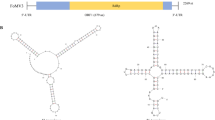Abstract
Penicillium oxalicum, an important biocontrol fungus in China, has been a subject of extensive study due to its role in combating various pathogenic fungi. Despite the prevalence of mycoviruses with double-stranded (ds) RNA genomes in filamentous fungi, there has been no screening of mycoviruses in P. oxalicum. In this report, we describe the identification and characterization of a novel dsRNA virus isolated from P. oxalicum, designated as "Penicillium oxalicum partitivirus 1" (PoPV1). The genome of PoPV1 consists of two dsRNA segments, dsRNA1 (1,770 bp) and dsRNA2 (1,584 bp), each containing a single open reading frame (ORF): ORF1 and ORF2. Comparative analysis revealed that the RdRp and CP amino acid sequences of PoPV1 share the highest identity (89.18% and 73.97%, respectively) with those of Penicillium aurantiogriseum partitivirus 1 (PaPV1). Motif analysis based on RdRp amino acid sequences places PoPV1 in the genus Gammapartitivirus within the family Partitiviridae, with a distinctive motif VI (R/KV/ILGDD). Phylogenetic analysis further established a close relationship of PoPV1 to PaPV1, forming a unique clade among the gammapartitiviruses. Consequently, we propose that Penicillium oxalicum partitivirus 1 represents a new species in the genus Gammapartitivirus. This is the first report of a dsRNA virus in P. oxalicum.


Similar content being viewed by others
Data availability
The datasets generated and/or analysed in the current study are available in the GenBank database.
References
Zhang X, Shi H, Li J, Wu X (2023) Complete genome sequence of a novel virus isolated from the phytopathogenic fungus Ceratobasidium sp. AG-A strain SHX-YJLC-1. Arch Virol 168(10):1–5
Vainio EJ, Chiba S, Ghabrial SA, Maiss E, Roossinck M, Sabanadzovic S, ICTV Report Consortium (2018) ICTV virus taxonomy profile: Partitiviridae. J Gen Virol 99(1):17–18
Lau SK, Lo GC, Chow FW, Fan RY, Cai JJ, Yuen KY, Woo PC (2018) Novel partitivirus enhances virulence of and causes aberrant gene expression in Talaromyces marneffei. Mbio 9(3):10–1128
Wang P, Yang G, Shi N, Zhao C, Hu F, Coutts RH, Huang B (2023) A novel partitivirus orchestrates conidiation, stress response, pathogenicity, and secondary metabolism of the entomopathogenic fungus Metarhizium majus. Plos Pathog 19(5), e1011397
Perrone G, Susca A (2017) Penicillium species and their associated mycotoxins. Methods in molecular biology. (Clifton N J) 1542:107–119
Murali M, Amruthesh KN (2015) Plant growth-promoting fungus Penicillium oxalicum enhances plant growth and induces resistance in pearl millet against downy mildew disease. J Phytopathol 163(9):743–754
Shen HD, Lin WL, Tam MF, Wang SR, Tzean SS, Huang MH, Han SH (1999) Characterization of allergens from Penicillium oxalicum and P. notatum by immunoblotting and N-terminal amino acid sequence analysis. Clin Exp Allergy 29(5):642–651
Karak P, Das S, Bhattacharya K (2018) Penicillium oxalicum. a dominant airborne fungal spore allergen from West Bengal, India
Chowdhary A, Kathuria S, Agarwal K, Sachdeva N, Singh PK, Jain S, Meis JF (2014) Voriconazole-resistant Penicillium oxalicum: an emerging pathogen in immunocompromised hosts. Open Forum Infect Dis 1(2):ofu029
Guevara-Suarez M, Sutton DA, Cano-Lira JF, García D, Martin-Vicente A, Wiederhold N, Gene J (2016) Identification and antifungal susceptibility of Penicillium-like fungi from clinical samples in the United States. J Clin Microbiol 54(8):2155–2161
Ellis LF, Kleinschmidt WJ (1967) Virus-like particles of a fraction of statolon, a mould product. Nature 215(5101):649–650
Banks GT, Buck KW, Chain EB, Himmelweit F, Marks JE, Tyler JM, Stone OM (1968) Viruses in fungi and interferon stimulation. Nature 218(5141):542–545
Wood HA, Bozarth RF, Mislivec PB (1971) Virus-like particles associated with an isolate of Penicillium brevicompactum. Virology 44(3):592–598
Border DJ, Buck KW, Chain EB, Kempson-Jones GF, Lhoas P, Ratti G (1972) Viruses of Penicillium and Aspergillus species. Biochem J 127(2):4P
Kim JW, Kim SY, Kim KM (2003) Genome organization and expression of the Penicillium stoloniferum virus S. Virus Genes 27:249–256
Nerva L, Forgia M, Ciuffo M, Chitarra W, Chiapello M, Vallino M, Turina M (2019) The mycovirome of a fungal collection from the sea cucumber Holothuria polii. Virus Res 273:197737
Herrero N, Duenas E, Quesada-Moraga E, Zabalgogeazcoa I (2012) Prevalence and diversity of viruses in the entomopathogenic fungus Beauveria bassiana. Appl Environ 78:8523–8530
Chen Y, Chen Y, Shi C, Huang Z, Zhang Y, Li S, Chen Q (2018) SOAPnuke: a MapReduce acceleration-supported software for integrated quality control and preprocessing of high-throughput sequencing data. Gigascience 7(1):gix120
Coutts RH, Livieratos IC (2003) A rapid method for sequencing the 5′-and 3′‐termini of double‐stranded RNA viral templates using RLM‐RACE. J Phytopathol 151(9):525–527
Katoh K, Rozewicki J, Yamada KD (2019) MAFFT online service: multiple sequence alignment, interactive sequence choice and visualization. Brief Bioinform 20(4):1160–1166
Kumar S, Stecher G, Li M, Knyaz C, Tamura K (2018) MEGA X: molecular evolutionary genetics analysis across computing platforms. Mol Biol Evol 35:1547–1549
Funding
This work was supported by the National Natural Science Foundation of China (grant no. 32172473).
Author information
Authors and Affiliations
Contributions
BH conceived and designed the study. JS and PW wrote the manuscript, conducted the experiments, and analyzed the data. HL and GY did a part of the experiments. BH edited the manuscript and supervised the project. All authors read and approved the manuscript.
Corresponding author
Ethics declarations
Ethical approval
This article does not contain any studies with human participants or animals performed by any of the authors.
Conflict of interest
The authors have no conflict of interest.
Additional information
Communicated by Massimo Turina
Publisher’s Note
Springer Nature remains neutral with regard to jurisdictional claims in published maps and institutional affiliations.
Electronic Supplementary Material
Below is the link to the electronic supplementary material
Rights and permissions
Springer Nature or its licensor (e.g. a society or other partner) holds exclusive rights to this article under a publishing agreement with the author(s) or other rightsholder(s); author self-archiving of the accepted manuscript version of this article is solely governed by the terms of such publishing agreement and applicable law.
About this article
Cite this article
Sun, J., Wang, P., Lu, H. et al. Complete genome sequence of a novel gammapartitivirus from Penicillium oxalicum RCEF7482. Arch Virol 169, 48 (2024). https://doi.org/10.1007/s00705-024-05987-8
Received:
Accepted:
Published:
DOI: https://doi.org/10.1007/s00705-024-05987-8




